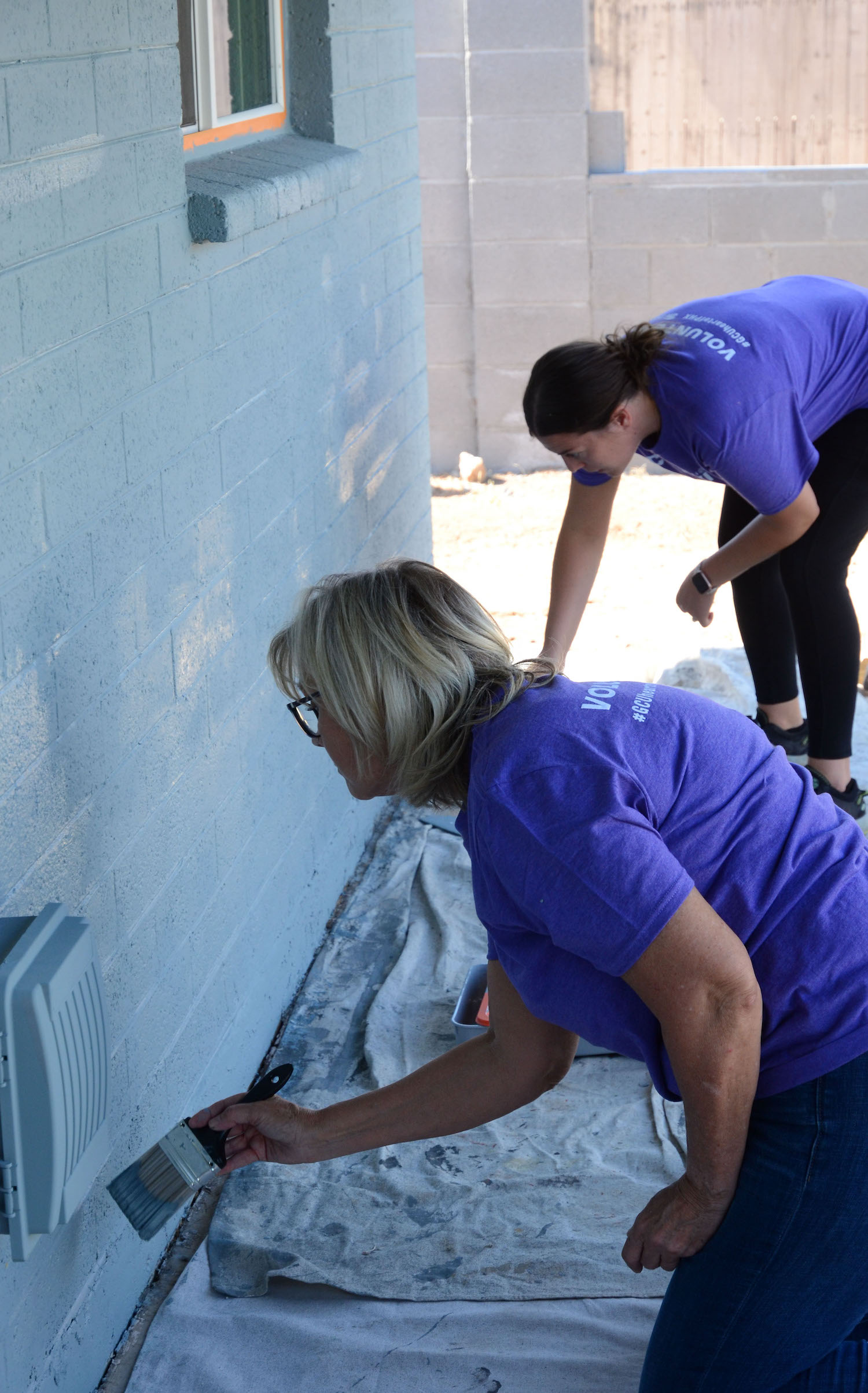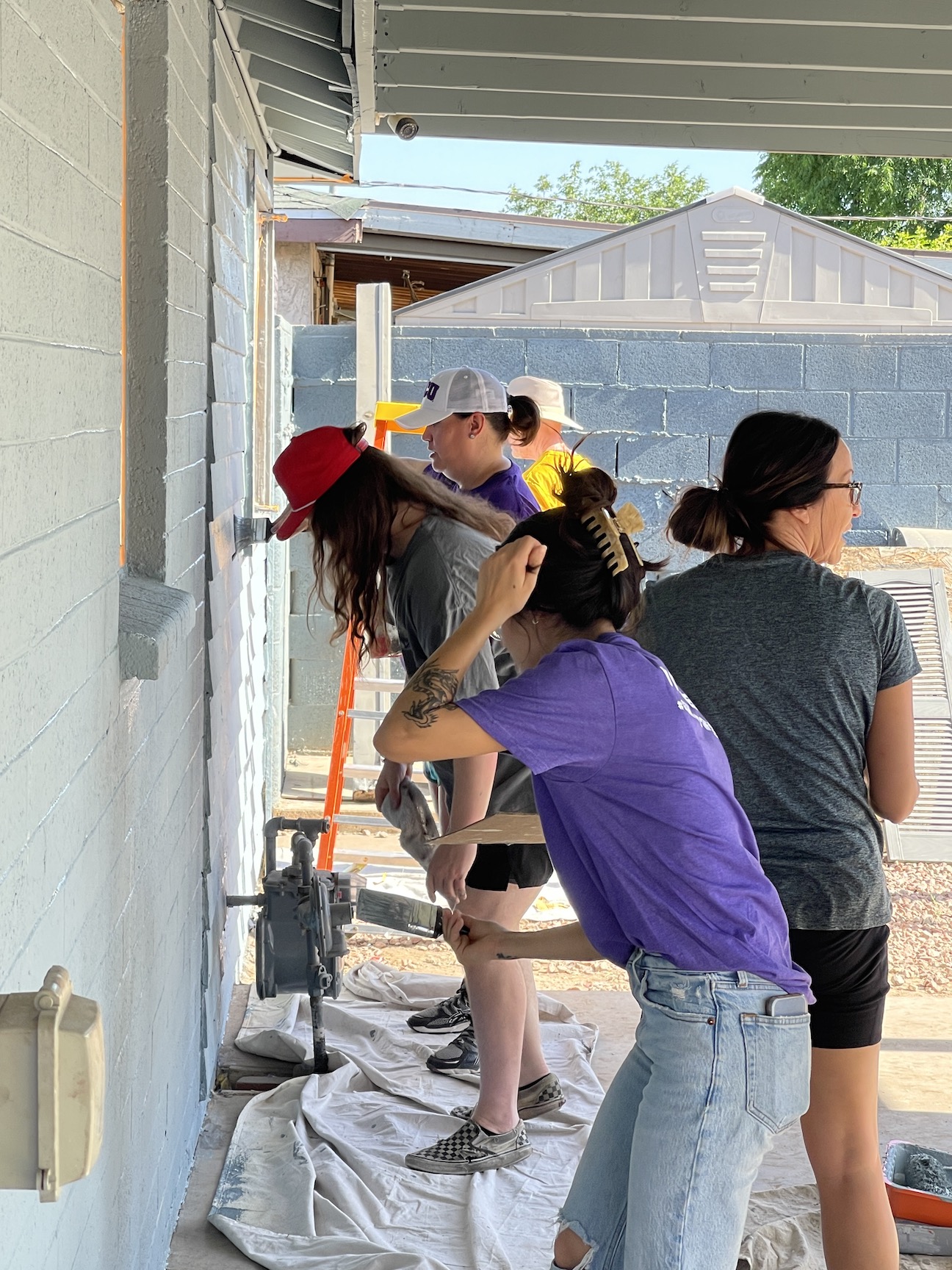By Jordan Gerard
Volunteers descended on a west Phoenix home at 7 a.m. on a Friday morning in May. Within an hour, the house was sporting a new blue wall color in addition to a fresh new coat of paint on the exterior window trim. Soon, the house will have new windows installed.
It’s one more family’s home that has been renovated or repaired, its value increased, and one more that will become part of the largest ongoing Habitat for Humanity project in Arizona.

The eight-year partnership between Habitat for Humanity Central Arizona and Grand Canyon University has resulted in 483 renovated homes and 1,226 repairs after 33,277 volunteer hours contributed by GCU employees and students. GCU has raised more than $5.4 million in funding for the projects.
GCU Vice Provost Dr. Jennifer Lech has volunteered with the Academic Leadership Team since 2015. It’s one of the ways GCU can give back to the community they live in, she said.
“It’s a great opportunity not just because we give back to the community, but the staff gets to have a place they can bond over and get to know each other,” she said. “It’s a win-win for the homeowner and GCU.”
The partnership is halfway to its goal of bolstering economic and cultural stability by repairing or renovating 700 households in neighborhoods near GCU’s campus. The program has expanded the service area from W. Bethany Home Rd. to W. Campbell Rd. and from I-17 to N. 43rd Ave., Habitat for Humanity Central Arizona Chief Marketing Officer Dusty Parsons said.
Once a semester on a Saturday morning, 300 people, mostly students, disperse amongst 10-12 homes to help complete critical home repairs like replacing old windows and doors; painting and landscaping; re-roofing; and replacing old HVAC systems and hot water heaters.
This weekend’s project was on the smaller side but generated the same amount of enthusiasm. Executive Director of Student Disability Services Beth Jamison said GCU students and staff can see the projects they work on from campus, and the neighborhood can see GCU right back.
“We show them we want to be part of that community,” she said.
GCU’s “Lopes Go Local” program provides an opportunity for volunteerism. Most students are not required to complete a certain amount of volunteer hours. Smaller monthly and weekly projects happen on Fridays and Saturdays, where faculty and staff volunteers have the opportunity to help, as well.

Parsons said it helps students gain a deeper understanding of the challenges and opportunities faced by the community and can lead to a more meaningful learning experience.
“We hear time and again from both the student volunteers and the homeowners we serve that the best part is working together and taking some time to get to know each other better while tackling a project like painting or landscaping,” Parsons said.
GCU moved to Phoenix about 15 years ago and made a $2 billion investment in its campus located along the 1-17 corridor in Phoenix. It’s a neighborhood full of many cultures, with about 45 different languages spoken within 10 square miles, Grand Canyon University President Brian Mueller said. With a new financial model in place, GCU wanted to build out its university but didn’t want to leave the neighborhood behind.
“We wanted the neighborhood to grow with the university, and for our students to see that and to sit in the classroom with kids that live in this very neighborhood,” Mueller said. “I think it’s a really important part of their education.”
The structure of GCU’s Five Point Plan aims to rebuild the surrounding inner city neighborhood into a middle class community through ways in which the government hasn’t been able to help, Mueller said. Those five points include serving families in need by distributing free household goods from GCU’s on-campus warehouse; making neighborhoods safer through an 11-year, $2.2 million partnership with the City of Phoenix; improving home values through the Habitat for Humanity partnership; supporting K-12 education with free tutoring services to any K-12 student and scholarships to high-achieving, low-income high school seniors; and creating 16,000 total jobs on and off campus in West Phoenix. Eight new businesses brought another 500 jobs.
GCU had to earn the trust of local residents first, as the neighborhood had been taken advantage of before, Mueller said. GCU’s and Habitat for Humanity’s shared commitment to faith helped in that aspect.
“We were doing this because we wanted their lives to improve. There was nothing to gain from our perspective,” he said.
Now, the program has become a familiar feature in the neighborhood. When about 300 people visit a neighborhood on a Saturday morning and divide up amongst 10 houses, ready to work, people aren’t surprised anymore, Mueller said.
“Nobody questions or wonders because they know who we are. They know what we’re doing, and they’re grateful for it,” Mueller said.

Improving home values could be challenging, but the partnership with Habitat for Humanity Central Arizona has made that process almost painless. The area’s 1960s-era homes needed significant upgrades and repairs and – thanks to Habitat’s building model – about 483 homes have received improvements and increased their value.
“What you see happen is that other neighbors will take a look at what’s going on with one home and start making improvements in theirs,” Mueller said. “The increase in the home values in this neighborhood has been amazing. It’s the largest increase in home values of any zip code area in the city of Phoenix.”
Habitat has been flexible with some home repairs. Usually, a homeowner is required to put sweat equity into the home building or repairs process, but some homeowners don’t have the physical ability, or lack family and friends to help to complete that requirement. In those cases, GCU has asked Habitat to waive the policy.
The program goes beyond homes, too. Schools with low resources are in need of gardens, playgrounds, and other features necessary to learning. Gardens providing science courses and playgrounds providing physical activity are just some of the ways that GCU and Habitat have helped. In some cases, they have rebuilt a playground in its entirety in a single weekend.
“It gives people, not just homeowners, but also kids going to schools, a sense of hope that [it’s] going to get better, and it’s worth investing here or staying here,” Mueller said.
Keep up with good, green news in our Good section.






